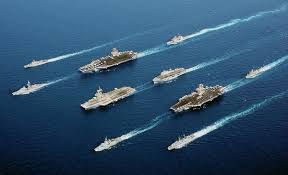Third plane carrying warship an operational has become a subject matter of debate within Indian military circles with the navy having to counter an equally potent argument on the survivability of the platform in the era of long-range stand-off weapons.
Indian Navy chief Admiral Karambir Singh has pitched for a third aircraft carrier with the Narendra Modi government calling it a necessity in the current security environment in Asia. Given that an aircraft carrier takes 18 years to build also keeping in mind the cabinet approval, as in the case of 37,000 tonne Vikrant, the Indian national security planners will have to take a call on the sea behemoth now with China planning six aircraft carriers of its own. Rising India, or what Admiral Karambir Singh defines as a five trillion-dollar economy, must have the tools of not only protecting itself but also projecting power.
The third aircraft carrier has become a subject matter of debate within Indian military circles with the navy having to counter an equally potent argument on the survivability of the platform in the era of long-range stand-off weapons. China, in fact, has DF-21 missile with 1700 km range which its propaganda machines call ship killer.

While the Indian Navy believes that it should not be tethered to the Indian peninsula for power project but be present on high seas and deep ocean, the current economic environment is not in favour of a machine that will cost nearly $10 billion. The navy wants a 65,000-tonne carrier with electromagnetic aircraft launch system unlike the ski jump STOBAR (short take-off, barrier arrested recovery system) onboard INS Vikramaditya and soon to be launched INS Vikrant.
The counter-argument of Indian security planners is that if India invests the same kind of money into converting some of its 1,062 island territories in Bay of Bengal, Arabian Sea and the Indian Ocean into military bases, then it can project air power beyond the horizon towards Malacca Straits and the Persian Gulf. The collateral benefit would be the development of the island territories as a replenishment bays for ships passing between nine degree and six-degree channels.
However, the first negative against permanent bases in island territories is that they would present a more vulnerable target to a stand-off weapon like Chinese “Guam killer” DF 26 missile than a moving airfield with both aircraft and missiles on board in either the Indian Ocean or the South China Sea.
With the Modi government’s doctrine post-Balakot and Uri being to extinguish the threat by hitting at the source, an aircraft carrier becomes a must-have operational requirement. The role of an aircraft carrier assumes much more significance in the context of China as Han power is buffered by occupied territories of Uighur dominated Xinjiang and Buddhist dominated Tibet, who don’t have a single issue with India. Hence, to deter Han China, India must have expeditionary force capability beyond Malacca Straits. To top it all, the geographical location of Indian island territories can project power deep into the Indian Ocean below the Bay of Bengal and south-east Asia but not towards the tip of Africa.

With Pakistan’s P 3C Orion armed with 280km range air to surface Harpoon missiles, the Indian Navy warships are vulnerable to the aerial threat unless there is a carrier force to not only nullify the threat but also deter the adversary. The time lag in getting a land-based fighter to take care of the aerial threat to an Indian ship also works in favour of an aircraft carrier, whose aircraft can take out a target within a range of 300 to 400 kilometres. “The air bubble of a carrier task force is a potent deterrent to any adversary. It has a sub-surface, surface, aerial and electronic warfare platforms to nullify the threat from all dimensions. The argument that carrier is vulnerable to stand-off weapons does not work as all systems are vulnerable,” said a top Indian admiral who once commanded the INS Viraat fleet.
The argument that India should go for more nuclear-powered submarines or SSNs with conventional weapons stands but a sub-surface platform cannot take care of an aerial threat carrying depth charges for anti-submarine warfare.
While it is nobody’s case that a third aircraft carrier should be given a priority by the national security planners in the current economic scenario, a token amount should be set aside for getting the plans developed as getting an aircraft carrier into sea takes a whole lot of time. India should not wake up a decade later to challenge the expansionist China, which has set its eyes on the Indian Ocean through satellite states like Pakistan and Myanmar.
Collect By: hindustantimes.com


Post a Comment